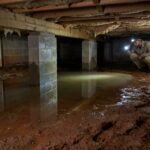Essential Guide to Effective Foundation Repair: Protecting Your Home from Structural Damage
Foundation repair might not be the first thing on your mind while sipping your morning coffee, but let’s face it: if your home’s foundation is compromised, that latte could soon become a distant memory as you deal with cracks and shifting walls. No one wants to find themselves in a situation where they’re staring at their lovely abode, only to notice a grand canyon emerging in the living room floor. So, let’s dive into the essential guide to effective foundation repair, arming you with the knowledge you need to protect your home from structural damage.
Understanding the Importance of Your Foundation
Your home’s foundation is like the unsung hero of the building world. It bears the weight of everything above – yes, even that gigantic collection of ceramic frogs you’ve accumulated over the years. If it falters, everything else does too. A solid foundation ensures your home remains stable, dry, and free from unpleasant surprises—unlike that specimen of a surprise birthday party you organized for your spouse last year.
Common Signs of Foundation Problems
Before we get into the nitty-gritty of fixing foundation issues, it’s important to know what signs to look for. Think of yourself as the Sherlock Holmes of home maintenance. Here are a few clues that may indicate foundation problems:
1. **Cracks in Walls or Floors**: If you’re noticing cracks appearing in your walls, especially around windows and doors, it’s time to investigate. It could be a minor settling issue, or it might signal that your foundation is waving the white flag.
2. **Doors and Windows That Stick**: An unwilling door or window can be more than just a nuisance. If you have to wrestle with them like they’re part of a WWE match, it might mean your foundation is shifting.
3. **Uneven Floors**: If your floors feel like they’re auditioning for a role in a funhouse, your foundation might be settling unevenly.
4. **Water Leaks in Basement**: Is your basement becoming a swimming pool with every rain? A compromised foundation might be allowing water to seep in, creating an unwanted indoor water feature.
5. **Gaps Between Molding and Walls**: Noticeable gaps can indicate that your house is shifting. It’s not trying to escape; it’s just having some foundational issues.
If you identify any of these signs, don’t panic. Just take a deep breath, lament the days when home maintenance was less of a concern, and keep reading.
Assessing the Severity of Foundation Issues
Once you’ve detected potential issues, the next step is to assess how bad it really is. You can do some preliminary evaluations yourself, or you may want to call in the professionals.
1. **DIY Inspection**: Grab a flashlight and examine your foundation closely. Look for cracks wider than 1/8 inch, as these often indicate serious issues. Check for other signs like bowing walls or mud stains—a delightful combination of home decor and structural failure.
2. **Professional Evaluation**: If things seem serious, hire a foundation specialist. They’ll have the experience and tools necessary to diagnose the issue correctly. Remember, this isn’t the time to play amateur handyman.
Types of Foundation Repairs
Depending on the severity of your foundation issues, several methods can be employed to fix them. Let’s explore some of the most common options without getting too technical (because nobody wants a headache).
1. **Slab Jacking**: This method involves injecting a mixture beneath the concrete slab to raise it back to its original position. Think of it as giving your home a little boost, much like that extra shot of espresso you rely on to get through the day.
2. **Piering**: In extreme cases, piers may need to be installed to stabilize the foundation. These piers extend deep into the ground to reach bedrock or stable soil. Imagine them as the supportive friends who show up during tough times, giving your home the stability it desperately needs.
3. **Reinforcing Beams**: Sometimes, beams need to be added to support the structure better. It’s similar to adding those trendy ceiling beams you see in home decor magazines; function meets flair!
4. **Wall Anchors**: If your walls are bowing due to soil pressure, wall anchors can help straighten them out. They anchor your walls back to the stable soil, rather like securing your favorite paintings against that oddly aggressive cat.
5. **Drainage Solutions**: Often, water pooling near your foundation causes issues. Installing proper drainage like French drains can prevent future mishaps. Think of it as giving your foundation a lovely raincoat for those stormy days.
Choosing a Foundation Repair Contractor
When it comes to choosing the right contractor, doing a bit of detective work is essential. Here are some tips to ensure you end up with a reliable professional instead of a smooth-talking scam artist:
1. **Research**: Look into local contractors with good reviews. Websites and platforms like Google Reviews, Yelp, or Angie’s List are great for this. If they don’t have reviews, it might be because their work is about as trustworthy as a used car salesman with an empty lot.
2. **Get Multiple Quotes**: Don’t settle for the first price you see. Get estimates from multiple contractors to ensure you receive a fair deal. This isn’t a yard sale; you don’t want to impulsively agree to the first offer.
3. **Check Credentials**: Ensure the contractor is licensed and insured. A valid license means they’ve passed necessary tests and regulations, while insurance protects you from potential liabilities.
4. **Ask for References**: A solid contractor will gladly provide references from past clients. If they hesitate, that’s a red flag. Let’s avoid hiring someone who’s more secretive than a magician with their tricks.
5. **Consider Experience**: Look for a contractor with a proven track record, particularly with your specific type of foundation problem. After all, you want someone seasoned, like a good steak, not someone fresh out of culinary school.
Maintaining Your Foundation
Once repairs are completed, it’s crucial to maintain your foundation to prevent future issues. Foundation maintenance sounds boring, but it’s like routine check-ups at the dentist. Here’s how to make it less “anxiety-inducing”:
1. **Manage Water Drainage**: Make sure rainwater is directed away from your foundation with proper gutters and downspouts. Think of it as the foundation’s personal moat, keeping it safe from siege.
2. **Landscaping**: Using appropriate landscaping techniques can protect your foundation. Mulch beds, flowers, and shrubbery should direct water runoff away rather than toward your home.
3. **Monitor Cracks**: Keep an eye on existing cracks. If they seem to grow or multiply, it might be time for another evaluation. It’s like watching for changes in your best friend’s mood; it’s all about being alert!
4. **Adjust Soil Moisture**: Maintain consistent moisture levels in the soil surrounding your foundation. Too much water can cause shifts, while too little can lead to drying out and settlement issues. It’s like finding that perfect balance in a yoga class – not too tense, not too relaxed.
5. **Routine Inspections**: Schedule periodic inspections to catch issues early before they escalate. Catching problems at their infancy is far less traumatic than dealing with a full-blown foundation crisis.
Conclusion
Foundation issues can feel daunting, like trying to assemble IKEA furniture without the instructions. However, with a little knowledge and proactive measures, you can protect your home from structural damage. Remember the signs to look out for, know when to call in the experts, and maintain your foundation diligently. Just think of your foundation as the base of a delicious cake—without it, everything else tends to crumble.
So, the next time you glance around your house and notice a crack, instead of panicking, remember this guide. With the right approach, knowledge, and a dash of vigilance, you can ensure your home remains a sturdy fortress for years to come!


